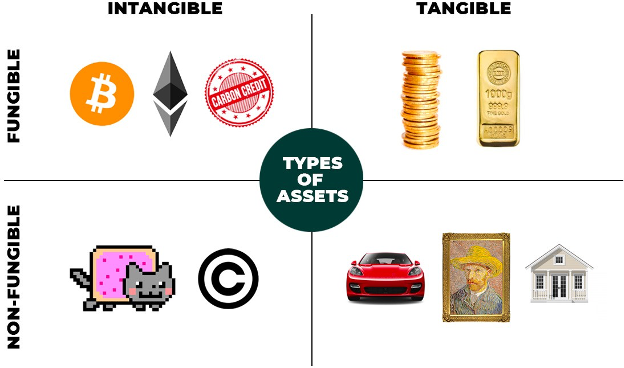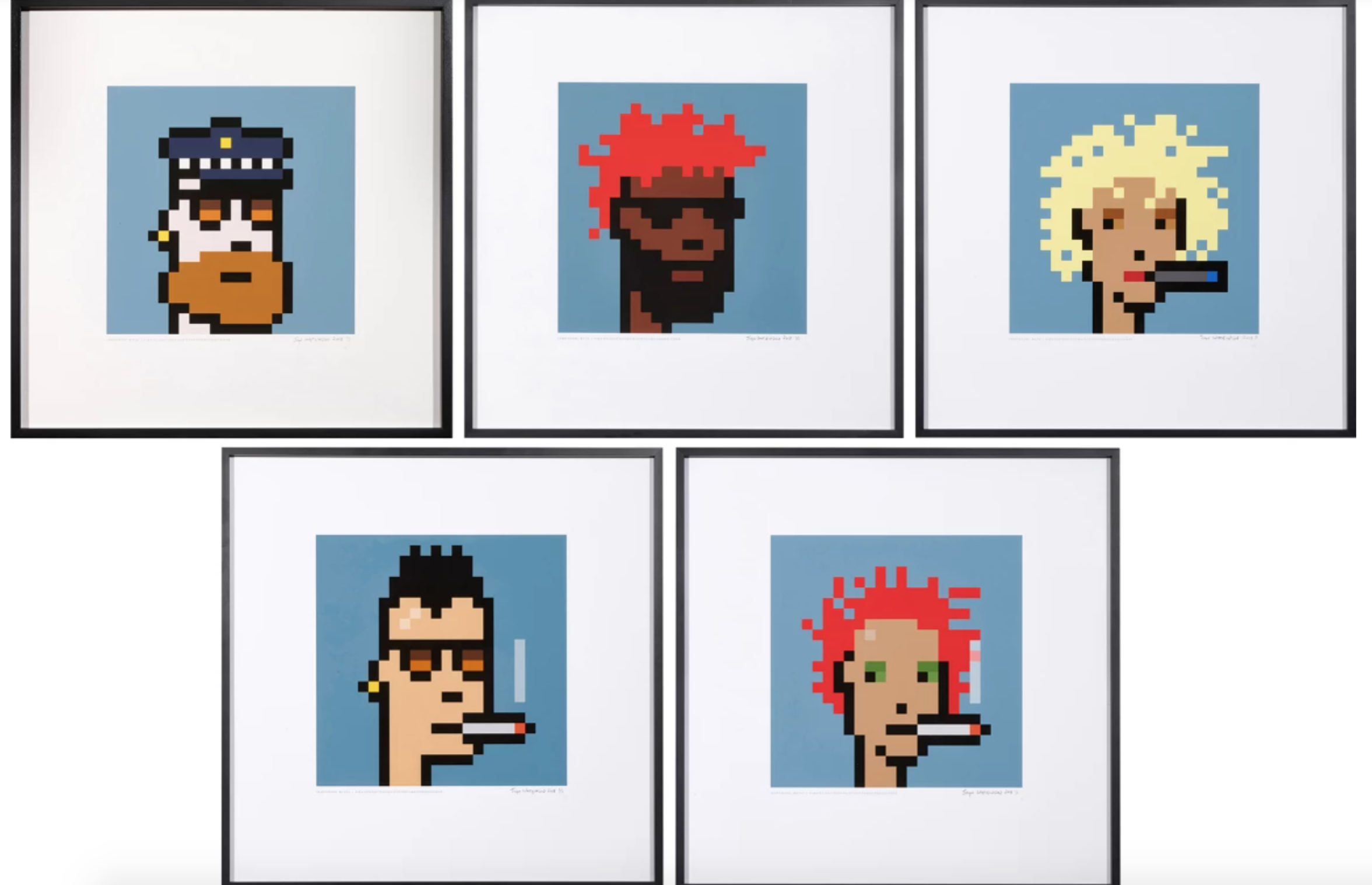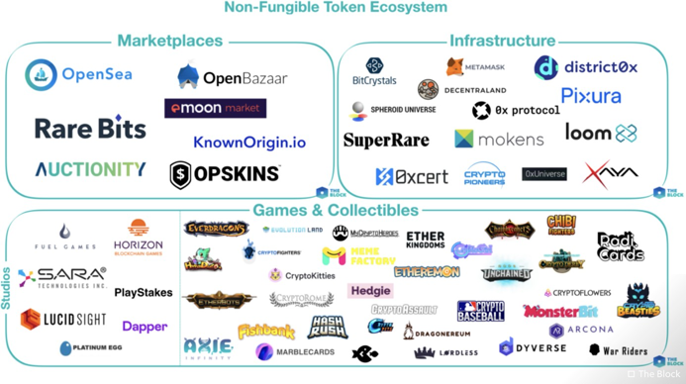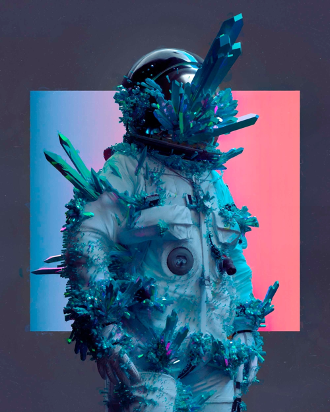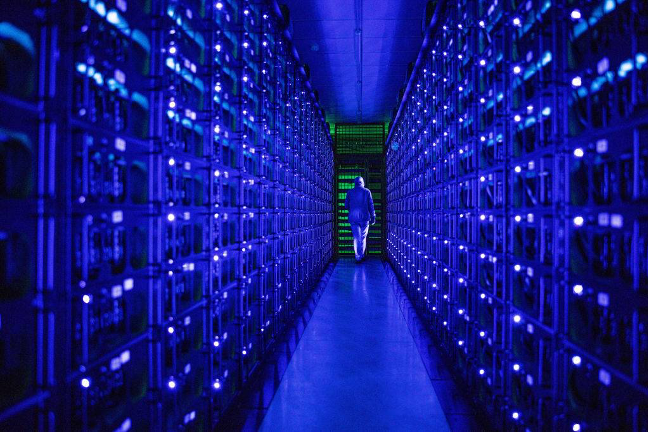Written by Rachel Korsen
In recent months, NFTs have had a large presence on news feeds, especially in artists’ circles. NFTs, or non-fungible tokens, are “digital assets that [represent] real-world objects like art, music, in-game items and videos.” Because of this, they are challenging the traditional ways that people view, buy, and sell artwork. This research will look at how NFTs came to be and what artists and arts administrators should consider when utilizing this technology.
What Are NFTs?
NFTs, or non-fungible tokens, are “digital assets that [represent] real-world objects like art, music, in-game items and videos.” NFTs have been around for quite some time, with the technology emerging in 2015. What’s really interesting about NFTs is that they aren’t just a digital asset like a traditional JPG or GIF file. They are a “digital certificate of authenticity.” They are reminiscent of the days when people would collect baseball cards and get the players’ signatures on them. With an NFT, people are able to verify the digital token’s ownership. The non-fungible part of the name means that “they cannot be traded or exchanged at equivalency.” This is completely different from something like a bitcoin, which is a fungible cryptocurrency. Fungible cryptocurrencies are equivalent to each other, allowing them to be used for traditional commercial transactions.
Figure 1: Illustration of fungible vs. non-fungible assets. Source: JingDaily.
NFTs utilize blockchain technology. Through the blockchain, NFTs can be created, bought, and traded. To give some context, the blockchain is a type of database that stores information electronically. What makes the blockchain different from traditional databases is how the data is structured: “A blockchain collects information together in groups, also known as blocks, that hold sets of information.” Each block has a set amount of storage capacity and, once the block is filled, it is “chained” to the previously filled block. A majority of NFTs exist on the Ethereum blockchain where there are “permanent digital records of all transactions using that cryptocurrency.”
Figure 2: Blockchain example. Source: Guru99.
For NFTs, each block has a hash that makes each NFT unique. One way to describe a hash is comparing it to a fingerprint. The “token owner owns a record and hash code that shows ownership of the unique token associated with the particular digital asset.” Having a unique hash is important for maintaining security throughout the different blocks as there are concerns of hackers tampering with the blocks and changing the hashes.
Figure 3: Illustration of blockchain hash. Source: Guru99.
How to Make an NFT
In order to get digital artwork onto the blockchain to create an NFT, it needs to be minted. Minting is “how your digital art becomes a part of Ethereum blockchain—a public ledger that is unchangeable and tamper proof.” In order to mint an NFT, one needs a crypto wallet. Using a site like OpenSea makes the process pretty easy. When your wallet is connected, users are able to drag media files into the site in a variety of formats like JPGs, PNGs, MP4s, etc. The site also allows users to specify how many copies of the NFT they want generated. Once that information is set, users can click “create” and, from there, it takes a few days to be verified. After that, users are able to sell their NFT. There are other sites, such as Rarible, on which users can create NFTs, but this is just one example of how to do so. Once this whole process is completed, the minted NFT sits in the wallet from which users can sell their NFTs on sites like OpenSea and Rarible.
Figure 4: Screenshot from OpenSea’s website. Source: Author.
Figure 5: Screenshot from OpenSea’s website. Source: Author.
History of NFTs
In 2012-2013, Colored Coins, “a denomination of a cryptocurrency, often Bitcoin, that is repurposed by marking it with metadata,” started. With Colored Coins, people were able to represent several different kinds of assets, such as property, subscriptions, and digital collectibles. The value of Colored Coins was established by people agreeing on what X amount of coins would represent. In 2014, Counterparty was created as a peer-to-peer financial platform. Moving into 2015, a game called Spells of Genesis utilized the blockchain for in-game assets. In 2016, Counterparty worked with a trading card game called Force of Will to introduce their cards onto the blockchain. Additionally, NFTs like CryptoPunks came out in 2017, where buyers could obtain one of the unique 10,000 generated assets for free. Some traits are more rare than others, but overall, each CryptoPunk is unique.
Figure 6: Rare Cryptopunk NFTs, iconic to the crypto art movement. Source: Sotheby’s.
NFTs started to gain a lot of traction in 2017 with a game called CryptoKitties in which users could adopt and trade virtual cats on the blockchain. CryptoKitties was so popular that, due to all of the trading, it even lagged the Ethereum blockchain. Seeing the success of CryptoKitties attracted investors from a16z and Google Ventures to enter the space. This represented a beginning in the NFT boom. There are now massive ecosystems for NFTs with hundreds of NFT projects as well as vibrant market places like OpenSea and SuperRare.
Figure 7: NFT Ecosystems. Source: Medium.
Impact on the Arts Industry
With NFTs becoming even more popular, they have started to impact traditional arts spaces. The most famous example of this is when Beeple sold an NFT for $69 million. Beeple, or Mike Winkelmann, is a digital artist who had been selling and creating his artwork for more than a decade. When selling his art, he was essentially barred from traditional auction houses because digital art “can be infinitely reproduced, making the works worthless.” As mentioned above, NFTs allow artists to create a digital asset that is a unique one of one (unless, of course, the creator chooses to specify a higher amount of digital reproductions). This is what helped Beeple’s art gain massive amounts of value.
Figure 8: Example of Beeple’s artwork. Source: CNN.
Figure 9: Beeple’s “EVERYDAYS: THE FIRST 5000 DAYS,” which sold for $69,346,250. Source: Christie’s.
Beeple’s work took off in the NFT markets, which eventually attracted traditional art auction houses such as Christie’s. One of Beeple’s pieces was minted exclusively for Christie’s and the digital collage of 5,000 images was sold for $69,346,250. This was the first time in history that an auction house sold a completely digital work and accepted cryptocurrency as the form of payment.
Another example of an NFT artwork selling in an auction house is the recent announcement that Sotheby’s will be selling the first ever minted NFT, Kevin McCoy’s Quantum, created in 2014.
Sotheby’s also conducted an NFT auction of digital works by the artist Pak. Nineteen thousand seven hundred thirty-seven “cubes” were sold for $17 million during a three-day sale. This sale was a collaboration between Sotheby’s and Nifty Gateway, which is an online marketplace for NFT trading. Nifty Gateway mentioned that they are “pleased that [Sotheby’s] is one of the earliest adopters from the traditional and fine art world to enter the NFT space.” Traditionally in auctions the buyers are anonymous, but in this auction, Sotheby’s listed the handle names of the auction winners. Something simple like that shows that Sotheby’s is really embracing the digital sphere even though NFT artwork is worlds apart from what it has traditionally auctioned over its lifetime.
Arts managers should take note of this shifting value of digital art as this example can be a really important shift for accessibility in the arts. With auction houses placing a larger value on digital arts, the sector may see a shift towards more digital exhibitions. In the digital space, arts managers can provide arts experiences to more people where the arts may have never been accessible to begin with. Additionally, with such a competitive landscape for artists, this provides a unique opportunity for artists to take control of their work, plan their own exhibitions digitally, and sell their uniquely minted NFT art.
NFT Marketplaces: Providing More Accessibility and Security for Artists
As the NFT space continues to grow, more and more artists have become interested in getting their work onto the blockchain. There are a large variety of art marketplaces, some of which are open to everyone and some that are invite only. Marketplaces like OpenSea, Rarible, Ethernity, and FansForever all are offering marketplaces for artists to share their work.
These online marketplaces for NFTs are creating a new dynamic for artists and buyers. A lot of creators didn’t necessarily understand what NFTs were but wanted to try it out as they saw NFTs gaining traction in the community. When people are buying art, they are doing research into the artists and making specific decisions about what they buy, often because “Buying in early to an artist’s work comes with a sense of ownership, like having seen a now famous band at its very first gig.” It’s a way for creators to develop their own fan base as opposed to slowly gathering a fan base through the usual social media channels like Facebook or Instagram.
Also, buyers are viewing these purchases as investments. This is an important shift, especially when artists are determining the value of their work, and it’s also a different viewpoint for buyers when they’re deciding their next investment. If an artist becomes really popular, there may be a high resale value for the buyer. For the artist, if they already have a lot of popularity, they may have an ability to charge more. It is an interesting dynamic when you start to view the art as an investment that can be resold.
Figure 12: “Unconditional” by Sam Clover. Source: MyNorthWest.
Because of these online market places, artists are now having opportunities to sell their work and many have even doubled their monthly income by selling NFTs. Artists now have an ability to bypass art dealers and go directly to the market. For arts managers, there are some barriers to entering this space because of the new terminologies. There is a bit of a learning curve with the terms as well as the process of creating NFTs.
Another benefit of NFTs for artists is “tracking copyright ownership and maintaining records of creation.” When an artist tokenizes their work, they are able to show proof of ownership and can then transfer that token to whoever they want. There are concerns about art theft with the blockchain which will be discussed below, but the idea of the blockchain providing this level of proof could be beneficial for artists.
There are also some NFTs that will automatically pay royalties to the artists when the piece is sold. For example, for NFTs minted on Foundation, artists receive “a 10% royalty in perpetuity, anytime a piece is resold. The royalty will be sent directly to the wallet that minted the NFT.” There is already an agreement structured between Foundation and other marketplaces, like Rarible and OpenSea, where all secondary market sales will receive 10% royalty if the work is resold in these markets. Overall, there are benefits with selling art as NFTs directly to buyers, but artists should still be aware of the varying costs with fees like, for example, daily fluctuating gas fees or converting other cryptocurrencies into Ethereum.
There are newer platforms like Mintbase that are providing lower gas fees as compared to Ethereum. With Ethereum’s growing popularity and clogged network came rising gas fees. Mintbase utilizes something called NEAR, which is a more “efficient contract execution model that requires less computation and uses a dynamic sharding approach called Nightshade.” Overall, there are systems being built to lessen these hidden costs and ultimately make it cheaper to make NFTs.
Disruptions Caused By NFTs
While there are benefits to NFTs for artists, they also come with some risks. The first issue comes with the fractionalization of NFTs. If there are expensive NFTs, fractionalization gives more people an opportunity to own a portion of an artwork. However, with so many people owning portions of the art comes the question of ownership. Issues can arise about who is the owner of the IP or just general contract issues. There is also a big concern that NFTs may be viewed as securities, which raises flags for financial regulators. This is mainly a concern for fractional NFTs.
Another issue with copyrights is if the person who purchased the NFT is now the copyright holder or if they only purchased a token and/or the right to resell the digital artwork they bought. The question comes down to “who owns the copyright for the work referenced in the NFT and who has the right to use the copyrighted work.” There are very specific nuances with copyright law, and now NFTs add an additional level to that nuance.
The third big issue is how NFTs impact the environment. The minting process for NFTs uses a process called mining which “involves complex puzzles, computing power, and a huge load of energy.” Ethereum’s process uses something called proof of work to create these digital assets. Proof of work is an algorithm that confirms transactions, creating new blocks in the blockchain. With this process comes major negative impacts on the environment. According to the Seattle Times, “An average NFT has an environmental footprint of over 200 kilograms of planet-warming carbon, equivalent to driving 500 miles in a typical American gasoline-powered car.” This is a big concern for the future of the environment and there should be a shift in focus to solar panels or another form of green energy to power mining rigs.
Figure 14: Mining rigs. Source: TIME.
Takeaways
Overall, NFTs are proving to be an interesting shift in the way art is bought and sold. It will be exciting to see the developments of how NFTs will expand into traditional spaces like auction houses and museums as well as what laws will come out to make sure artists maintain the rights to their minted work. Lastly, I hope in the near future alternative green energy sources will provide a power source for mining rigs. If NFTs continue on a positive trajectory with their popularity, we will want to be conscious of how we are impacting the environment, finding greener ways to mint and mine in the crypto space.
+ Resources
Adam, Georgina. “But Is It Legal? The Baffling World of NFT Copyright and Ownership Issues.” The Art Newspaper. The Art Newspaper, April 6, 2021. https://www.theartnewspaper.com/analysis/but-is-it-legal-the-baffling-world-of-nft-copyright-and-ownership-questions.
Akhtar, Tanzeel. “Sotheby's Moves Into 'New World' of Digital Art and NFTs.” CoinDesk. CoinDesk, March 16, 2021. https://www.coindesk.com/sothebys-moves-into-new-world-of-digital-art-and-nfts.
Ayson, Samantha. “A Complete Guide to Minting an NFT.” Foundation Help Center, May 8, 2021. https://help.foundation.app/en/articles/4742869-a-complete-guide-to-minting-an-nft#:~:text=Minting%20an%20NFT%20is%20how,minted%E2%80%9D%20once%20they%20are%20created.
Baloyan, Sergey. “How To Mint Your First NFT (Non-Fungible Token) For Free.” Hacker Noon, April 24, 2021. https://hackernoon.com/how-to-mint-your-first-nft-non-fungible-token-for-free-b42j33ek.
Barber, Gregory. “NFTs Are Hot. So Is Their Effect on the Earth's Climate.” Wired. Conde Nast, March 6, 2021. https://www.wired.com/story/nfts-hot-effect-earth-climate/.
Bechara, Kristel. “NFT The Future of Digital Art: Crypto Art.” NFT DIGITAL ART, April 12, 2021. https://www.atelierkristel.com/nft-digital-art/.
“Blockchain Explained... in under 100 Words.” Deloitte Switzerland. Accessed May 7, 2021. https://www2.deloitte.com/ch/en/pages/strategy-operations/articles/blockchain-explained.html.
Boscovic, Dragan. “How Nonfungible Tokens Work and Where They Get Their Value – a Cryptocurrency Expert Explains NFTs.” The Conversation. Accessed May 1, 2021. https://theconversation.com/how-nonfungible-tokens-work-and-where-they-get-their-value-a-cryptocurrency-expert-explains-nfts-157489.
Botz, Anneli. “Is Blockchain the Future of Art? Four Experts Weigh In.” Art Basel. Art Basel, December 7, 2018. https://www.artbasel.com/news/blockchain-artworld-cryptocurrency-cryptokitties.
Calma, Justine. “The Climate Controversy Swirling around NFTs.” The Verge. The Verge, March 15, 2021. https://www.theverge.com/2021/3/15/22328203/nft-cryptoart-ethereum-blockchain-climate-change.
Cascone, Sarah. “A Collective Made NFTs of Masterpieces Without Telling the Museums That Owned the Originals. Was It a Digital Art Heist or Fair Game?” Artnet News. Artnet News, March 22, 2021. https://news.artnet.com/art-world/global-art-museum-nfts-1953404.
Chow, Andrew R. “What Are NFTs and Why They Are Shaking Up the Art World?” Time. Time, March 22, 2021. https://time.com/5947720/nft-art/.
Clark, Mitchell. “NFTs, Explained.” The Verge. The Verge, March 11, 2021. https://www.theverge.com/22310188/nft-explainer-what-is-blockchain-crypto-art-faq.
Coggan, Georgia. “The Best NFT Artwork Created so Far.” Creative Bloq. Creative Bloq, April 10, 2021. https://www.creativebloq.com/features/nft-artwork.
Conti, Robyn, and John Schmidt. “What You Need To Know About Non-Fungible Tokens (NFTs).” Forbes. Forbes Magazine, April 29, 2021. https://www.forbes.com/advisor/investing/nft-non-fungible-token/.
Contributor, TechTarget. “What Is Colored Coin? - Definition from WhatIs.com.” WhatIs.com. TechTarget. Accessed May 5, 2021. https://whatis.techtarget.com/definition/colored-coin#:~:text=A%20colored%20coin%20is%20a,represent%20other%20things%20of%20value.
Conway, Luke. “Blockchain Explained.” Investopedia. Investopedia, November 17, 2020. https://www.investopedia.com/terms/b/blockchain.asp.
Dash, Anil. “NFTs Weren't Supposed to End Like This.” The Atlantic. Atlantic Media Company, April 2, 2021. https://www.theatlantic.com/ideas/archive/2021/04/nfts-werent-supposed-end-like/618488/.
Droitcour, Brian. “How to Look at NFTs.” ARTnews.com, March 4, 2021. https://www.artnews.com/art-in-america/features/nft-art-1234585590/.
English, Jennifer, Toby Futter, Dave Grable, Emily Kapur, Luke Nikas, and Robert Schwartz. “NFTs: Legal Risks from ‘Minting’ Art and Collectibles on Blockchain.” JD Supra. Accessed May 6, 2021. https://www.jdsupra.com/legalnews/nfts-legal-risks-from-minting-art-and-4997056/.
Fairley, Gina. “NFTs: The Pros and Cons.” ArtsHub Australia. ArtsHub Australia, April 6, 2021. https://www.artshub.com.au/education/news-article/opinions-and-analysis/professional-development/gina-fairley/nfts-the-pros-and-cons-262268#:~:text=Pros%3A%20There%20are%20two%20positives,separated%20from%20the%20NFT%20artwork.
Finley, Klint, and Gregory Barber. “Blockchain: The Complete Guide.” Wired. Conde Nast. Accessed July 9, 2019. https://www.wired.com/story/guide-blockchain/.
Foster, Max. “What Are NFTs and Can Photographers Really Benefit From Them?” Max Foster Photography. Accessed May 7, 2021. https://www.maxfosterphotography.com/gallery/what-is-an-nft-how-can-photographers-and-artists-benefit/.
Garnett, Karen, Frank Zarb, and Jeffrey Neuburger. “NFTs Are Interesting but Fractionalized Non-Fungible Tokens (F-NFTs) May Present Even More Challenging Legal Issues.” The National Law Review, April 22, 2021. https://www.natlawreview.com/article/nfts-are-interesting-fractionalized-non-fungible-tokens-f-nfts-may-present-even-more.
Garza, Alejandro de la. “NFTs Art's Hidden Environmental Cost.” Time. Time, March 18, 2021. https://time.com/5947911/nft-environmental-toll/.
Goldman, Jeremy. “A Primer on NFTs and Intellectual Property.” Lexology, March 11, 2021. https://www.lexology.com/library/detail.aspx?g=d96ed012-8789-4e87-bc1d-70ba76569c0f.
Guy, Jack. “Artwork Made of 5,000 Images Captured over 13 Years to Go on Sale in Auction House First.” CNN. Cable News Network, February 17, 2021. https://www.cnn.com/style/article/beeple-digital-art-auction-scli-intl/index.html.
Jiang, Yaling. “How China's Art Market Embraced NFTs.” Artsy, May 4, 2021. https://www.artsy.net/article/artsy-editorial-chinas-art-market-embraced-nfts.
Kastrenakes, Jacob. “Beeple Sold an NFT for $69 Million.” The Verge. The Verge, March 11, 2021. https://www.theverge.com/2021/3/11/22325054/beeple-christies-nft-sale-cost-everydays-69-million.
“Making Sense of Bitcoin, Cryptocurrency and Blockchain.” PwC. Accessed May 7, 2021. https://www.pwc.com/us/en/industries/financial-services/fintech/bitcoin-blockchain-cryptocurrency.html.
McDonnell, Hilary. “The Unknown Legal Future of the Art Market's New Favorite Medium: Non-Fungible Tokens (‘NFTs’).” HHR Art Law, April 9, 2021. https://www.hhrartlaw.com/2021/04/the-unknown-legal-future-of-the-art-markets-new-favorite-medium-non-fungible-tokens-nfts/.
Morris, David Z. “Where Does Your Blockchain Art Really Live?” Fortune. Fortune, March 10, 2021. https://fortune.com/2021/03/10/are-your-nfts-on-the-wrong-blockchain/.
Newsdesk, Dazn. “What Are NFTs? How Do I Buy Them? How Can I Sell Them?: DAZN News US.” DAZN. DAZN News US, May 8, 2021. https://www.dazn.com/en-US/news/boxing/what-are-nfts-how-do-i-buy-them-how-can-i-sell-them/6lzungqnrak01lbd4pu4c6oc9.
“NFT Blockchain Drives Surge in Digital Art Auctions.” BBC News. BBC, March 3, 2021. https://www.bbc.com/news/technology-56252738.
Ohlheiser, Abby. “Is the New Boom in Digital Art Sales a Genuine Opportunity or a Trap?” MIT Technology Review. MIT Technology Review, March 25, 2021. https://www.technologyreview.com/2021/03/25/1021215/nft-artists-scams-profit-environment-blockchain/.
Patterson, Dan. “Blockchain Company Buys and Burns Banksy Artwork to Turn It into a Digital Original.” CBS News. CBS Interactive, March 4, 2021. https://www.cbsnews.com/news/banksy-nft-injective-destroy-art-digital-token/.
Pires, Samantha. “Crypto Art: How Artists Are Selling Their Work on Blockchain.” My Modern Met, February 10, 2021. https://mymodernmet.com/crypto-art-blockchain/.
Rapoza, Kenneth. “NFTs Are Increasingly Taking Us Into A World Of Make Believe.” Forbes. Forbes Magazine, May 2, 2021. https://www.forbes.com/sites/kenrapoza/2021/05/02/nfts-are-increasingly-taking-us-into-a-world-of-make-believe/?sh=2f9089326ccf.
Richardson, Jim. “Museum NFT ‘Art Heist’ Sees Famous Artworks Sold Online.” MuseumNext, March 13, 2021. https://www.museumnext.com/article/nft-art-heist-museums/.
Sharma, Rakesh. “Non-Fungible Token (NFT).” Investopedia, March 18, 2021. https://www.investopedia.com/non-fungible-tokens-nft-5115211.
Shimon, Yonatan Ben. How Non-Fungible Tokens are Revolutionizing the Art World. Nasdaq, May 3, 2021. https://www.nasdaq.com/articles/how-non-fungible-tokens-are-revolutionizing-the-art-world-2021-05-03.
Small, Zachary. “As Auctioneers and Artists Rush Into NFTs, Many Collectors Stay Away.” The New York Times. The New York Times, April 28, 2021. https://www.nytimes.com/2021/04/28/arts/design/nfts-art-collectors-copyright.html.
Tabuchi, Hiroko. “NFTs Are Shaking up the Art World. They May Be Warming the Planet, Too.” The Seattle Times. The Seattle Times Company, April 18, 2021. https://www.seattletimes.com/business/technology/nfts-are-shaking-up-the-art-world-they-may-be-warming-the-planet-too/.
Thaddeus-johns, Josie. “What Are NFTs, Anyway? One Just Sold for $69 Million.” The New York Times. The New York Times, March 11, 2021. https://www.nytimes.com/2021/03/11/arts/design/what-is-an-nft.html.
“Top NFT Marketplaces for Creators to Sell Non-Fungible Tokens.” Influencer Marketing Hub, April 26, 2021. https://influencermarketinghub.com/nft-marketplaces/.
“What Is a Non-Fungible Token (NFT)?” Sanction Scanner. Accessed May 7, 2021. https://sanctionscanner.com/blog/what-is-a-non-fungible-token-nft-375#:~:text=What%20makes%20an%20NFT%20unique,asset%20interoperability%20across%20multiple%20platforms.
“What Is Blockchain Technology - IBM Blockchain.” IBM. Accessed May 7, 2021. https://www.ibm.com/topics/what-is-blockchain.
“What Is Blockchain Technology? How Does It Work?: Built In.” What Is Blockchain Technology? How Does It Work? | Built In. Accessed May 8, 2021. https://builtin.com/blockchain.
“What Is Blockchain?” Blockchain Explained: What is blockchain? | Euromoney Learning. Euromoney. Accessed May 8, 2021. https://www.euromoney.com/learning/blockchain-explained/what-is-blockchain.
Whiddington, Richard. “The Potential And Pitfalls Of NFTs In The Museum Sphere.” Jing Culture and Commerce, April 30, 2021. https://jingculturecommerce.com/cuseum-nfts-in-museum-sector-webinar-takeaways/.
Willis, Simon. “Crypto Millionaires' Love of NFTs Is a Boon for the Aging Art Market-but Galleries May Miss Out.” Fortune. Fortune, April 14, 2021. https://fortune.com/2021/04/14/nft-non-fungible-token-art-crypto-art-market-galleries-auction-houses/.


